|
|
前面两讲说到了,安装MySql数据库,安装ODBC驱动以及使用CDatabase操作数据库的基本操作比如Add del edit,链接如下:
visual c++ 2008进行MySQL编程(ODBC) -- (一) 套装安装
visual c++ 2008进行MySQL编程(ODBC) --二 操作数据库
visual c++ 2008进行MySQL编程(ODBC) --三 查询数据库
visual c++ 2008进行MySQL编程(ODBC)-- (四) 终极实现 之 派生CRecordset 上
visual c++ 2008进行MySQL编程(ODBC)-- (四) 终极实现 之 派生CRecordset 中
今天引入一个新的类,CRecordset,其实前面的编程操作对于CRecordset类而言,相对而言就非常的弱小了呵呵,后续一一说到吧。今天的工作就是使用这个类遍历一下我们数据库里面的条目。
继续在上一个文章的工程上做这一切。
一、在对话框里面托一个listtree控件,修改属性为报表模式:
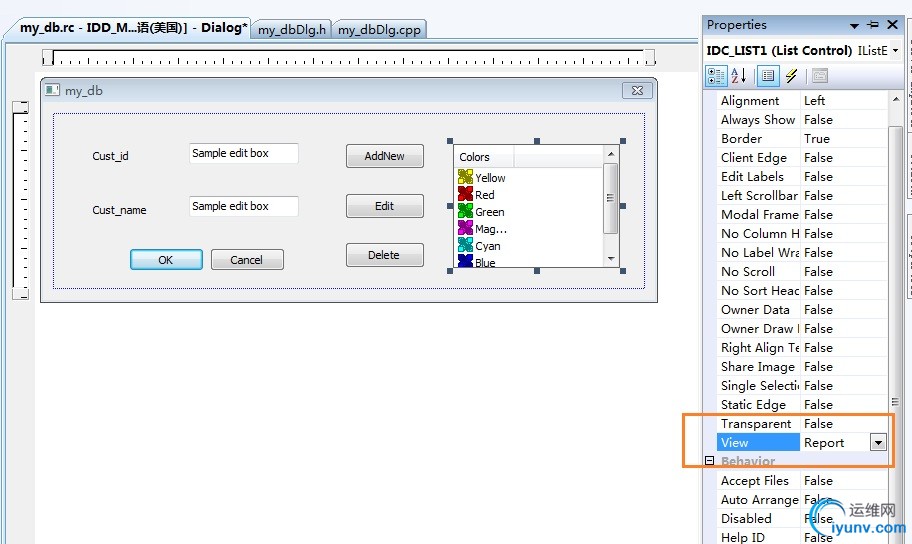
上图的黄色的框框的属性要修改report,报表格式。
二、给这个新加的list control添加成员变量,m_list_ctrl:
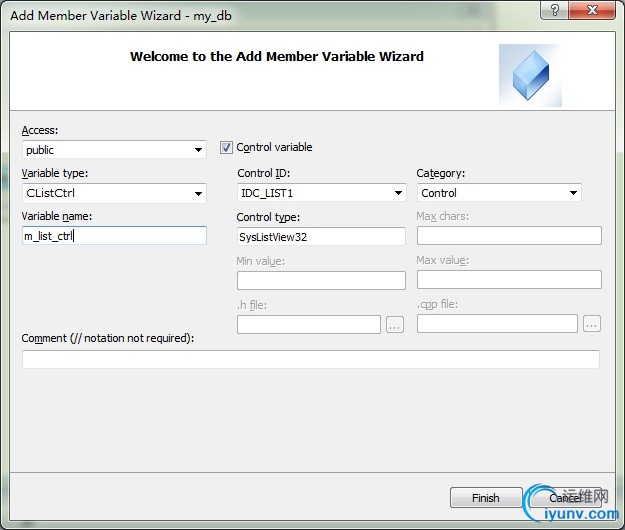
三、在Cmy_dbDlg类的初始化函数OnInitDialog()里面添加添加的list control的初始化代码:
m_list_ctrl.InsertColumn( 0, _T("Cust Id"), LVCFMT_CENTER, 70 );//插入列
m_list_ctrl.InsertColumn( 1, _T("Cust Name"), LVCFMT_CENTER, 85 );
四、添加一个按钮,用作查询,同时给这个按钮添加Cmy_dbDlg的单击响应函数:
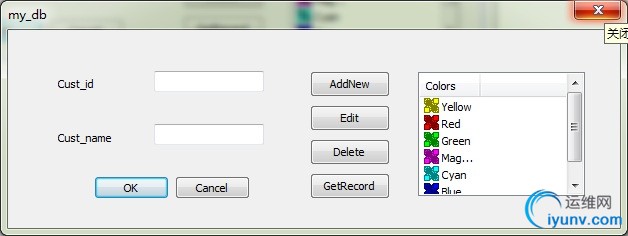
查询的按钮就是上图的GetRecord。
消息响应函数为:
void Cmy_dbDlg::OnBnClickedGetAllItem()
{
// TODO: Add your control notification handler code here
}
四、现在来实现这个消息函数,我们使用类CRecordset,具体的要使用的函数,我们看看MSDN的文档:
Opens the recordset by retrieving the table or performing the query that the recordset represents.
virtual BOOL Open(
UINT nOpenType = AFX_DB_USE_DEFAULT_TYPE,
LPCTSTR lpszSQL = NULL,
DWORD dwOptions = none
);
Returns nonzero if the recordset has been positioned before the first record. There is no current record.
BOOL IsBOF( ) const;
Returns nonzero if the recordset has been positioned after the last record. There is no current record.
BOOL IsEOF( ) const;
Makes the first record in the next rowset the current record.
void MoveNext( );
Open函数打开指定的数据库,之后才可以遍历,如果数据库为空,则IsBOF返回true,如果需要遍历每一条,则使用MoveNext( )。
使用起来就是这么简单。
五、OnBnClickedGetAllItem()的实现修改如下:
void Cmy_dbDlg::OnBnClickedGetAllItem()
{
// TODO: Add your control notification handler code here
CRecordset my_record(&m_db_opr);
try
{
int count = 0;
CString str;
my_record.Open(CRecordset::snapshot, _T("select * from customer"));
if(my_record.IsBOF())
{
return;
}
while(!my_record.IsEOF())
{
my_record.GetFieldValue((short)0, str);
m_list_ctrl.InsertItem(count, str);
my_record.GetFieldValue(1, str);
m_list_ctrl.SetItemText(count, 1, str);
my_record.MoveNext();
count++;
}
}
catch(CDBException* pe)
{
// The error code is in pe->m_nRetCode
pe->ReportError();
pe->Delete();
}
}
现在解释一下上面的代码吧,Open函数还是请大家参考一下MSDN呵呵,第一个参数可以为:
CRecordset::dynaset A recordset with bi-directional scrolling. The membership and ordering of the records are determined when the recordset is opened, but changes made by other users to the data values are visible following a fetch operation.
Dynasets are also known as keyset-driven recordsets.
CRecordset::snapshot A static recordset with bi-directional scrolling. The membership and ordering of the records are determined when the recordset is opened; the data values are determined when the records are fetched. Changes made by other
users are not visible until the recordset is closed and then reopened.
CRecordset::dynamic A recordset with bi-directional scrolling. Changes made by other users to the membership, ordering, and data values are visible following a fetch operation. Note that many ODBC drivers do not support this type of recordset.
CRecordset::forwardOnly A read-only recordset with only forward scrolling.
For CRecordset, the default value is CRecordset::snapshot. The default-value mechanism allows the Visual C++ wizards to interact with both ODBCCRecordset and DAOCDaoRecordset, which have
different defaults.
具体我就不翻译了,mysql的ODBC貌似只支持snapshot,就是快照,静态的获取当前的数据库里面的条目数。
Open的第二个参数,是一个字符串,就是用于查询数据库的的sql语句。
编译代码,运行,我们执行一下,单击GetRecord按钮就能查询到当前的所有条目,如图:
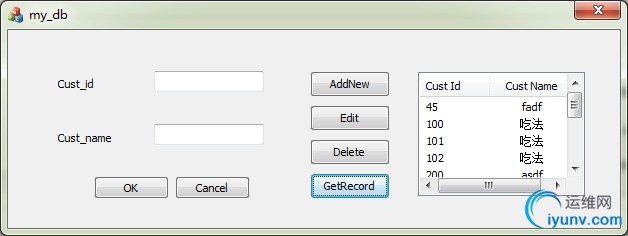
挺完美对吧。
还没有结束,还要继续说说如何设定查询范围,设定排序方式等等。
六、我们设定过滤规则,比如我想要查询100<= x <= 200范围内的cust id的条目,如何进行?
解决这个问题需要求助于
m_strFilter
这个成员变量了,所以我们在Open函数调用之前,设定查询范围,如下:
my_record.m_strFilter = _T("cust_id <= 200 and cust_id >= 100");
my_record.Open(CRecordset::snapshot, _T("select * from customer"));
那么修改后面的OnBnClickedGetAllItem函数如下:
void Cmy_dbDlg::OnBnClickedGetAllItem()
{
// TODO: Add your control notification handler code here
CRecordset my_record(&m_db_opr);
try
{
int count = 0;
CString str;
my_record.m_strFilter = _T("cust_id <= 200 and cust_id >= 100");
my_record.Open(CRecordset::snapshot, _T("select * from customer"));
if(my_record.IsBOF())
{
return;
}
while(!my_record.IsEOF())
{
my_record.GetFieldValue((short)0, str);
m_list_ctrl.InsertItem(count, str);
my_record.GetFieldValue(1, str);
m_list_ctrl.SetItemText(count, 1, str);
my_record.MoveNext();
count++;
}
}
catch(CDBException* pe)
{
// The error code is in pe->m_nRetCode
pe->ReportError();
pe->Delete();
}
}
我们可以看到,查询结果如下图:
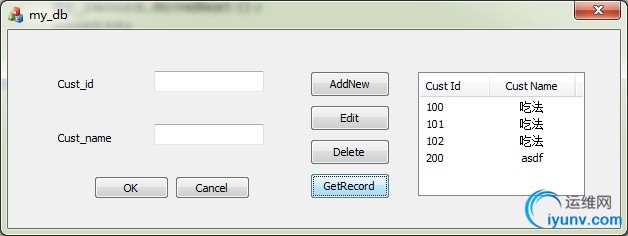
但是我们知道,设定查询范围怎么弄?需要where 子句,比如 :
select * from customer where cust_id <= 200 and cust_id >= 100;
但是使用了m_strFilter这个作为过滤规则的设定,就不能使用带上where了。
七、我们可以设定排序规则,比如按照cust id排序,而且是逆序,这个操作就要借助于
m_strSort
了,也只要设定排序对象就是了:
my_record.m_strFilter = _T("cust_id <= 200 and cust_id >= 100");
my_record.m_strSort = _T("cust_id desc");
my_record.Open(CRecordset::snapshot, _T("select * from customer"));
和上面过滤的规则一样,sql语句是需要Order by子句的,如果使用了m_strSort之后,那么就不能有“order by”了,而这个语句:
my_record.m_strSort = _T("cust_id desc");
就相当于, “order by cust_id desc” 子句了。
修改后的消息响应函数就是这个样子的了:
void Cmy_dbDlg::OnBnClickedGetAllItem()
{
// TODO: Add your control notification handler code here
CRecordset my_record(&m_db_opr);
try
{
int count = 0;
CString str;
my_record.m_strFilter = _T("cust_id <= 200 and cust_id >= 100");
my_record.m_strSort = _T("cust_id desc");
my_record.Open(CRecordset::snapshot, _T("select * from customer"));
if(my_record.IsBOF())
{
return;
}
while(!my_record.IsEOF())
{
my_record.GetFieldValue((short)0, str);
m_list_ctrl.InsertItem(count, str);
my_record.GetFieldValue(1, str);
m_list_ctrl.SetItemText(count, 1, str);
my_record.MoveNext();
count++;
}
}
catch(CDBException* pe)
{
// The error code is in pe->m_nRetCode
pe->ReportError();
pe->Delete();
}
}
执行一下程序,自然就逆序打印了:
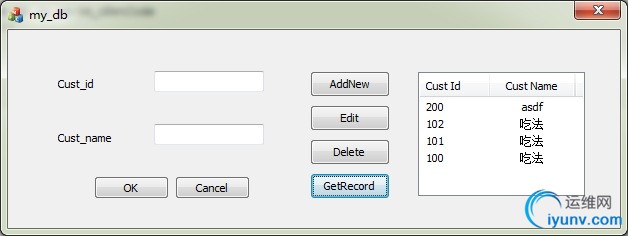
是不是很不错啊?
还是那句话,如果有下一个博文,我会继续说更好的使用visual c++ 2008对mysql数据库编程的实现。
|
|